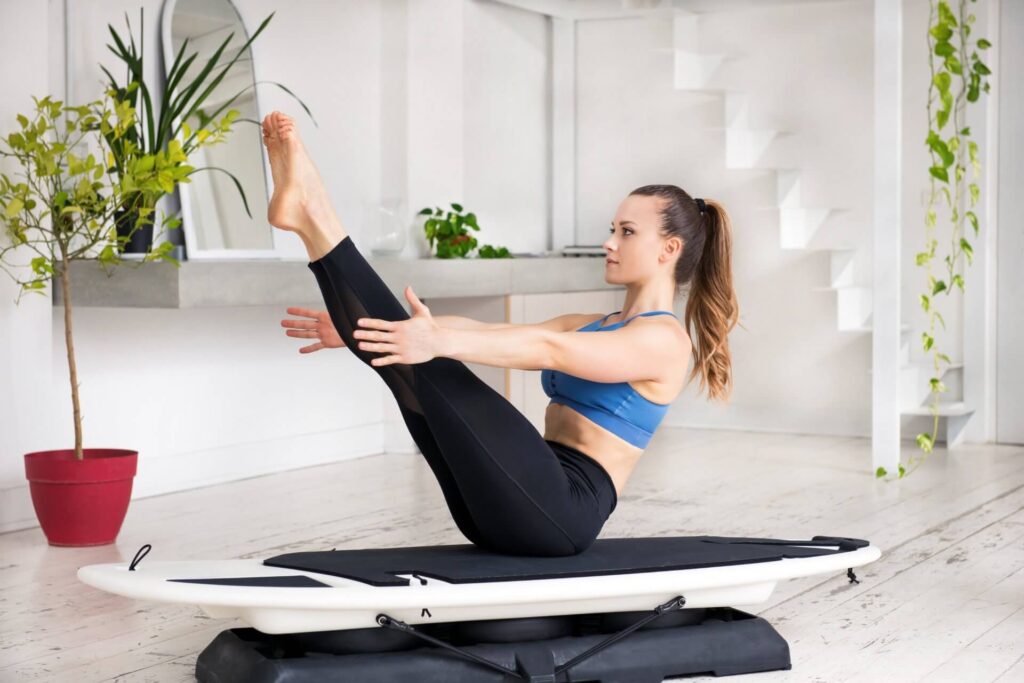“The Boat Pose, an ode to resilience, where we sail through the waves of life, like boats of light, carrying the cargo of our dreams.” Boat Pose Navasana (Intermediate)
Boat Pose, known as Navasana in Sanskrit, is an intermediate-level yoga posture that embodies core strength, balance, and stability. In this asana, practitioners sit with their legs extended, lifting them off the ground while simultaneously balancing on their sit bones and holding their arms parallel to the legs, creating a challenging and empowering boat-like shape. Navasana offers an engaging challenge for those looking to advance their yoga practice beyond the basics.
This pose is celebrated for its ability to strengthen the core, improve balance, and foster a sense of physical and mental stability. It encourages both strength and mindfulness. Whether you’re progressing from an intermediate level or seeking to refine your practice, this comprehensive guide will introduce you to the essential techniques and alignment cues for Boat Pose (Navasana), allowing you to experience its physical and mental benefits as an intermediate practitioner.
Navasana Meaning
Navasana, or Boat Pose, has deep roots in ancient yogic traditions. The name “Navasana” is derived from the Sanskrit words “nava,” which means “boat,” and “asana,” which means “pose.” This pose symbolizes the steadiness and balance of a boat gliding gracefully on water, reflecting the harmony and equilibrium we strive to attain in our practice.
Strengths and Benefits Boat Pose Navasana
Despite its intermediate level, Boat Pose offers a wide range of advantages for your physical and mental well-being:
- Core Strengthening: It is a powerhouse for the core muscles, engaging and toning the abdominals, obliques, and lower back.
- Improved Balance: Navasana challenges your balance and stability, fostering concentration and mindfulness.
- Leg Strength: The pose strengthens the muscles of the thighs and hip flexors, promoting lower body strength.
- Digestive Health: Regular practice can stimulate the abdominal organs, aiding digestion and alleviating minor digestive issues.
- Enhanced Confidence: As you master Boat Pose, it can boost your confidence and self-esteem.
How To Do Boat Pose Navasana

Boat Pose Navasana step-by-step instructions:
- Starting Position: Begin by sitting on your mat with your knees bent and feet flat on the ground. Place your hands behind your hips, fingers pointing toward your feet.
- Engage Core: Engage your core muscles by drawing your navel in toward your spine.
- Lift Legs: As you exhale, lean back slightly, balancing on your sit bones. Lift your feet off the ground, bringing your shins parallel to the floor.
- Extend Arms: Extend your arms forward, parallel to the ground, in line with your legs.
- Maintain Alignment: Keep your back straight, avoiding rounding or arching. Your body should form a V shape.
- Gaze Forward: Fix your gaze on a point in front of you to maintain balance.
- Hold and Breathe: Stay in Boat Pose for 15-30 seconds or longer, maintaining steady breathing.
Difficulty Level and Duration
Navasana is an intermediate-level pose, but it can be modified to suit various fitness levels. The duration can vary based on your experience. Beginners may start with shorter holds and gradually extend to 30 seconds or more as they progress.
Preparation Poses Boat Pose Navasana
- Half Boat Pose (Ardha Navasana): This preparatory pose helps build core strength and balance, making it an excellent precursor to the full Boat Pose. Sit on the floor with your knees bent and feet flat. Lean back slightly, keeping your back straight, and lift your feet off the ground while extending your arms forward. Hold this position and engage your core.
- Supine Hand-to-Big-Toe Pose (Supta Padangusthasana): This pose improves hamstring flexibility and leg strength, which are essential for Boat Pose. Lie on your back, bend one knee, and use a strap to hold the extended leg. Gradually straighten the raised leg, keeping it aligned with your hip, and hold the stretch.
- Plank Pose: Strengthening your core and upper body in Plank Pose helps you maintain stability in Boat Pose. Begin in a push-up position with your arms straight and shoulders aligned with your wrists. Keep your body in a straight line from head to heels, engaging your abdominal muscles.
Alternative Poses Boat Pose Navasana
- Child’s Pose (Balasana): After practicing Boat Pose, release any tension in your lower back and hips with Child’s Pose. Kneel on the floor, sit back on your heels, and extend your arms forward, lowering your chest toward the ground.
- Bridge Pose (Setu Bandha Sarvangasana): Counterbalance the Boat Pose by stretching the front of your body in Bridge Pose. Lie on your back with your knees bent and feet hip-width apart. Press through your feet and lift your hips off the ground, creating a bridge-like shape with your body.
- Seated Forward Bend (Paschimottanasana): To alleviate any strain in the spine and hamstrings, practice Seated Forward Bend. Sit with your legs extended in front of you, flex your feet, and hinge at your hips to reach for your toes. Keep your back straight and bend as far as comfortable.
Final Thoughts
Boat Pose, or Navasana, embodies the essence of balance and strength. As you incorporate this intermediate-level pose into your practice, may you discover the physical and mental equilibrium it nurtures.
May Boat Pose remind you that, like a boat gliding gracefully on water, you possess the inner strength and balance to navigate the currents of life. With each practice, may you find increased core strength and a deeper sense of harmony on your self-care journey.


